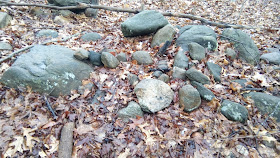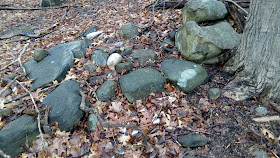My friend
Dr. Johnnie Rock Lobster writes to me a while back:
1.) “The placement of rock art motifs/panels/stone
features on the landscape is selective (the pattern is not always obvious, but
there are physiologically-informed and culturally-mediated reasons why certain
locales are selected over others);
2. Rock art motifs/panels/stone features on the
landscape exhibit self-similar properties at different scales (the Russian
doll-within-doll idea is that the big natural bedding plane, that resembles a
snake, contains numerous painted depictions of smaller rattle snakes);
3.) The rock/terrain surface is as significant as
the rock art motifs/panels/stone features (e.g., it provides a pre-figured 3D canvas created by spirit
beings that then need people to reciprocate likewise);
4.) Rock art motifs/panels/stone features on the
landscape are interactive, even long after their production (e.g., live snakes
coming in and out of the "dead" natural one);
5.) Bodily movements in and around rock art panels
and stone features on the landscape are significant (note how your snake head
changed when you crossed the threshold/veil). So all-in-all, there is good
reason to claim that rock art/stone features in its original physical context
has a certain degree of agency, one that facilitates informed visitors
(informed by having in-depth knowledge of the culture involved) to relive
certain experiences and beliefs of the original makers...” - J.R. Lobster (pers. comm.)
A
Moravian Missionary wrote about the ability of an “Indian acquaintance and
friend” to do much the same using face paint for an unspecified “dance.”
“As I was once resting in my travels at the house
of a trader who lived at some distance from an Indian town, I went in the
morning to visit an Indian acquaintance and friend of mine. I found him engaged
in plucking out his beard, preparatory to painting himself for a dance which
was to take place the ensuing evening. Having finished his head dress, about an
hour before sunset, he came up, as he said, to see me, but I and my companions
judged that he came to be seen. To my utter astonishment, I saw three different
paintings or figures on one and the same face. He had, by his great ingenuity
and judgment in laying on and shading the different colours, made his nose
appear, when we stood directly in front of him, as if it were very long and
narrow, with a round knob at the end, much like the upper part of a pair of
tongs.

On one cheek there was a red round spot, about the size of an apple, and
the other was done in the same manner with black. The eye-lids, both the upper
and lower ones, were reversed in the colouring.
When we viewed him in profile
on one side, his nose represented the beak of an eagle, with the bill rounded
and brought to a point, precisely as those birds have it, though the mouth was
somewhat open. The eye was astonishingly well done, and the head, upon the
whole, appeared tolerably well, shewing a great deal of fierceness.
When we
turned round to the other side, the same nose now resembled the snout of a
pike, with the mouth so open, that the teeth could be seen.
He seemed much
pleased with his execution, and having his looking-glass with him, he
contemplated his work, seemingly with great pride and exultation. He asked me
how I liked it? I answered that if he had done the work on a piece of board,
bark, or anything else, I should like it very well and often look at it. But,
asked he, why not so as it is? Because I cannot see the face that is hidden
under these colours, so as to know who it is. Well, he replied, I must go now,
and as you cannot know me to-day, I will call to-morrow morning before you leave
this place. He did so, and when he came back he was washed clean again.
Thus, for a single night's frolic, a whole day is
spent in what they call dressing, in which each strives to outdo the other
(page 102).”
John
Gottlieb Ernestus Heckewelder
History,
Manners, and Customs of the Indian Nations Who Once Inhabited Pennsylvania and the
Neighbouring States
Every
once in a while, I wonder if some Ceremonial Stone Landscape Features had at
one time (or at certain times?) had also been painted, as documented in certain
places.
Kevin Callahan: “In the 1840's artist Henry Lewis
painted a scene of the Red Rock published in his book The Valley of the
Mississippi Illustrated. The boulder in the lower left corner next to the tree
is thought to be the Red Rock at its original location several miles south of
St. Paul on the Mississippi river:”
“This
painted boulder has been moved many times since then to protect it from damage
by steamboat passengers and others. One individual apparently even wanted to
blow it up with dynamite as a pagan idol. It now resides in front of the United
Methodist Church of Newport, Minnesota.”

"The beliefs and customs surrounding the Red Rock is
typical of a wider rock art and religious phenomenon in the Upper Midwest -
namely Native American religious customs and beliefs that concerned glacial
erratics and other significant stones within the sacred landscape which were
often painted and decorated as part of their religion."
“Other
celebrated spots in the Dakota sacred landscape were the Pipestone Quarry with
its enormous granite boulders called "the Three Maidens" which at one
time were literally surrounded by a circle of petroglyphs, and Carvers Cave in
St. Paul which was covered in petroglyphs that were recorded by Theodore H.
Lewis.”
"Wakinyan, or the Thunder-bird had its chief dwelling place in Brown's Valley in far western Minnesota. Brown's Valley had several boulders covered with thunderbird symbols - sometimes referred to in rock art literature as "turkey tracks."

















































